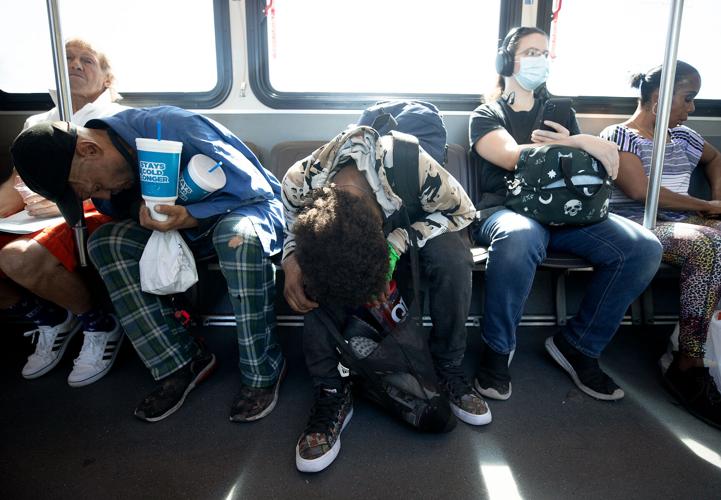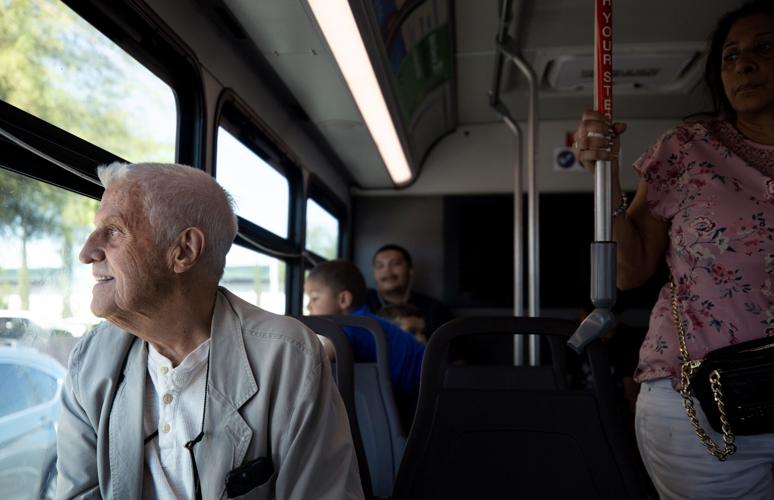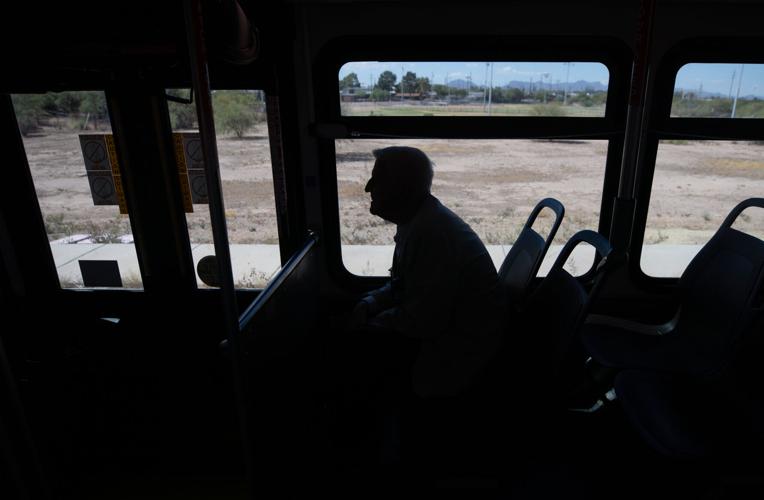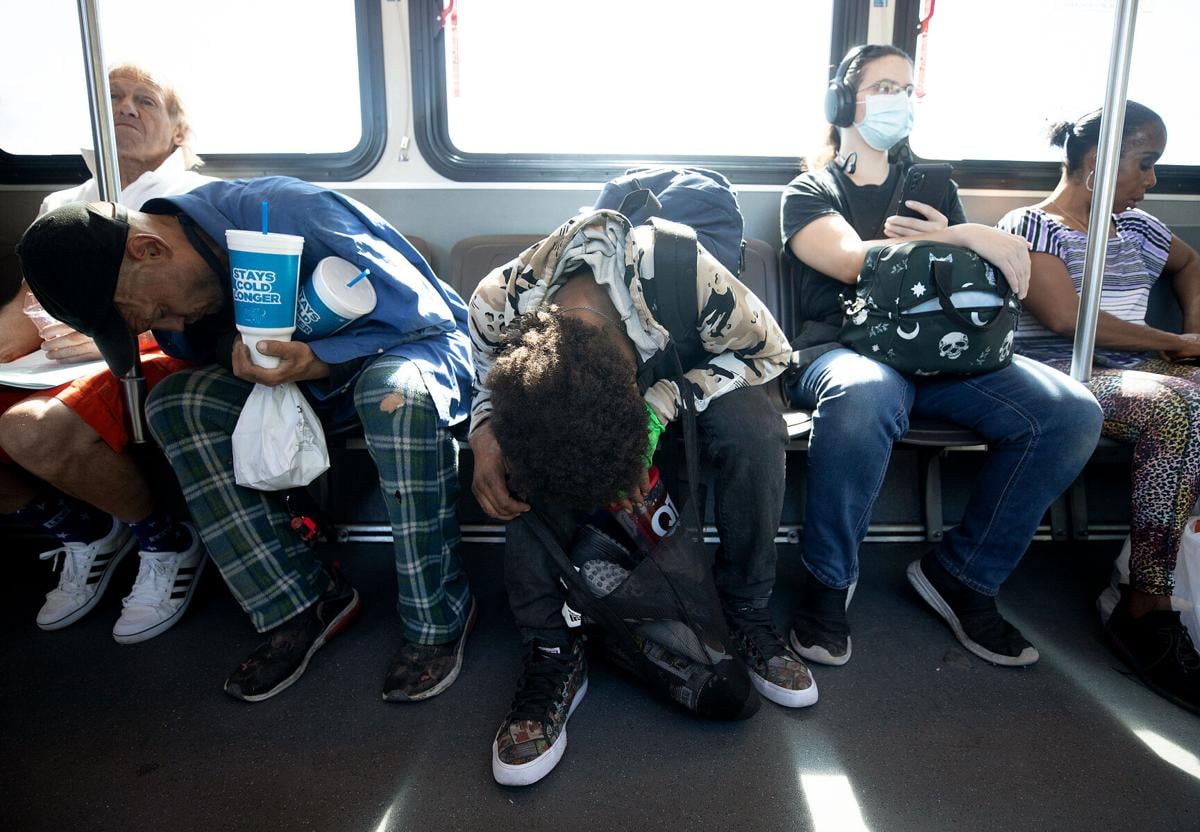For months, John Troy Vaughn Jr. has been touring what some other Tucsonans call the “crime bus.”
Vaughn, 86, occasionally takes Sun Tran for routine errands, but earlier this year, he began a systematic tour of the city’s bus routes. He started with Route 1, and on Tuesday got up through Route 11, riding a crowded bus down South Alvernon Way and Palo Verde Road, along Ajo Way and to the Laos transit center.
Then he rode back.
“It gets me out,” Vaughn said. “It’s fun to see the people and really get a feel for the city.”
Photographer Mamta Popat and I traveled with Vaughn Tuesday on what turned out to be his busiest bus ride yet. At its peak the bus had 30 or more people on board and was standing room only.
Vaughn got a view of it all from his seat in the front of the elevated rear section of the bus, his favored spot. As to whether he’s had hassles on the bus, Vaughn said “none — no problems at all.”

John Troy Vaughn, left, looks out window as the Sun Tran bus approaches a stop on Tuesday. Opponents of free fares call Sun Tran the “crime bus,” but Vaughn has ridden over ten routes thus far and doesn’t see it that way.
His experience runs counter to a narrative that has grown stronger during this city election season. Since fares have become free, some say, Sun Tran has become the “crime bus,” where people take drugs, escape with stolen property and even assault drivers or passengers.
During a Sept. 30 City Council candidate forum, Ward 1 Republican candidate Victoria Lem told of how her special-needs son stopped riding the bus.
“He used to use the Sun Tran city bus to get to and from work,” she said. “He was taught how to do that. However, since it’s become free, it’s become a crime bus instead of a good, reliable, affordable mode of transportation.”
Republican candidate for mayor Janet “JL” Wittenbraker asserted at a forum Oct. 7 that “crime has gone up exponentially on our buses with the fare-free transit.” She said the first thing she would do as mayor would be to ask the council to return to charging fares.
Independent candidate Ed Ackerley has also called for ending fare-free bus rides, but he said he would maintain them on the streetcar.
‘Crime bus’ doesn’t match experience
For me, it’s been tough to reconcile my experiences on the bus and streetcar with the “crime bus” label applied by some candidates, as well as the Tucson Crime Free Coalition, a group advocating changes in local public-safety policies.
My rides have been largely uneventful, but I am only an occasional rider of public transit — maybe a few times a month — so my experiences aren’t necessarily representative.
Still, in my conversations with more regular bus riders, I have received mostly blasé responses. In general, they haven’t had the alarming experiences of assaults or drug-use that led to the “crime bus” nickname. It’s also possible that they are thicker-skinned than the average Tucsonan who buzzes around town alone in their car.
The drivers’ union says it’s been bad, though. In a May, 2022 letter the secretary-treasurer of Teamsters Local 104, Karla Schumann, blamed fare-free transit for a decline in ridership by average Tucsonans going to work, school and appointments, and an increase in crime. She advocated for re-imposing fares.

John Troy Vaughn stays in his seat as the Sun Tran bus approaches a stop on Tuesday. Opponents of free fares call Sun Tran the "crime bus," but Vaughn has ridden over ten routes thus far and doesn't see it that way.
Last week, though, Schumann noted that drivers are instructed only to ask passengers for fares once, and not to escalate if passengers refuse.
“Collect fares, don’t collect fares — it really doesn’t matter,” Schumann told me. “The people that are problematic to the ridership, to the community, they’re not going to pay the fare regardless. They’re not rule-followers.”
What’s most needed, she said, is a stronger effort to improve security. Although Sun Tran and the city have beefed up patrols at transit centers and on buses, it hasn’t been enough, Schumann said.
Free fares not main problem
This isn’t just because of everyone’s need to accurately assess their risks, or because elections may ride on it. We’re also talking about money.
Now that federal money that flowed during the pandemic has run out, it costs around $9 million per year to run the system fare-free. Fares don’t make up much of the total cost of operating our transit system — about 8.7 percent — but that money has to come from somewhere.
The city has been appealing to outside institutions like the University of Arizona, Pima Community College and Raytheon to help bear that burden, but there’s no long-term funding source yet. As of now, the free fares will conclude at the end of December.
Council member Lane Santa Cruz, the incumbent Democrat representing Ward 1, has been one of the leaders on the council advocating for finding a way to make free fares permanent. She told me she feels more concerned about safety when she’s in crowds.
“Prior to the pandemic, the No. 1 safety issue for bus drivers was fare collection. Once the pandemic hit, it was masks — asking riders to wear masks,” Santa Cruz said. “When I have been on the bus and I’ve talked to people, they have expressed that their concern would be if we went back to fare collection, the confrontations between drivers and passengers would create an unsafe situation.”
Maybe the problem isn’t so much the free fares, but the problems that emerged in society during the pandemic and coincided with free fares. That, plus our inadequate response to public drug use, fighting and disorder, may be what is really keeping people like Lem’s son off the bus.
In an interview, Lem said her son’s ability to ride the bus “gave him a lot of freedom” that has now been taken away.
“He’s not a violent kid. He’s not a street-smart kid. He needs to be protected out there.”
Risk perceptions differ
If we can’t protect people like Lem’s son, we may not be able to get up to the ridership levels of the pre-pandemic years, when fares were required, let alone to the high usage levels you’d expect from a free transportation system.
Sun Tran ridership was at 15.2 million in 2018 before dropping a bit in 2019, then descending to 10.9 million in 2021. It was back up to 13 million in 2022 and is on pace to reach 14.6 million this year.
I would think that in an era of high gas prices, more people would be opting for the free option. But people have their habits, and they have different perceptions and levels of tolerance.
The risk of being injured and having your property damaged in a car crash is significant, as you may have seen on the roads lately. This year 34 people have been killed on Tucson roads, double the number at this time last year. Nobody has been killed on Sun Tran.
That isn’t to say it couldn’t happen. When we were riding with Vaughan up North Alvernon Way Tuesday, a young man got onto the bus carrying a knife in a sheath tied around his waist. Popat, my colleague, subtly moved away from him. Others seemed to keep a wary eye on him as he jittered and bounced his knee.
When he got off a mile or so later, I asked Vaughn if he’d seen the knife. He hadn’t.
The driver told me later that if he notices a weapon on a rider, he monitors them and calls in security if he sees anything bad starting to happen.
Nothing happened in this case. But I can see why that sort of thing would keep some people from riding the bus, free fares or not.







